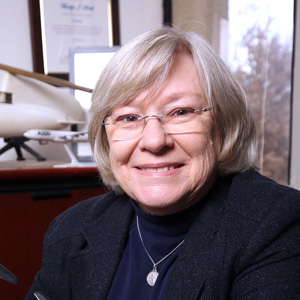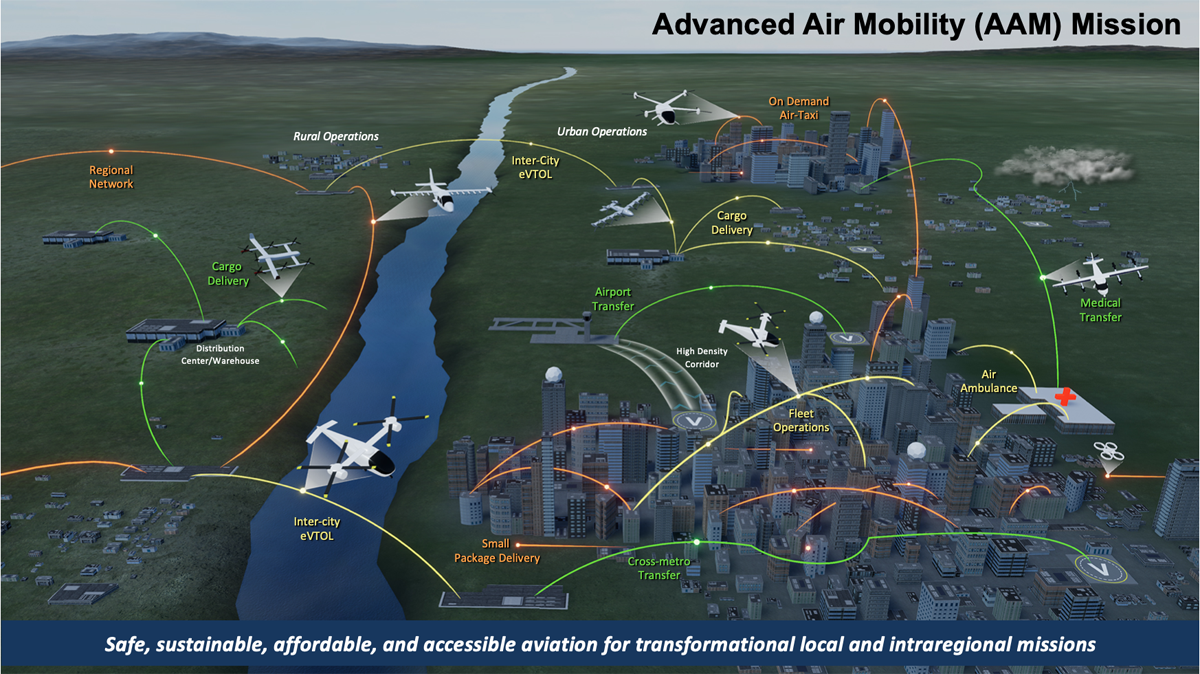
The Future is Up: In the future, a wide variety of piloted and autonomous vertical lift vehicles will be used for civilian applications such as passenger travel and cargo delivery in urban environments. (credit: NASA)
Personal air vehicles, delivery drones, air taxis, and even air buses for both passenger travel and cargo delivery in urban environments may seem futuristic, but with recent advancements in aerospace technologies, they are fast becoming a reality. For this to happen, these piloted or autonomous vertical lift vehicles – any aircraft that can hover, take off, and land vertically – designed for civilian applications will use rotorcraft technology similar to what is used in traditional piloted helicopters.
 |
| Prof. Marilyn Smith |
However, the range in size and function of the vertical lift vehicles will vary greatly. Unlike traditional helicopters, these large and small drone-like aircraft will have to meet a fundamentally different set of requirements, due to their smaller size, longer flight hours for continuous delivery services, and the technical challenges of flying in different environmental conditions such as urban canyons where wind gusts are common.
To address the technical barriers associated with these new civilian applications for developing vertical lift vehicles, NASA has awarded a $5.37M University Leadership Initiative (ULI) grant to a team of researchers, industry engineers, and maintenance faculty led by Georgia Tech. Over the next three years, the team will research and demonstrate ways to implement new structural materials, manufacturing techniques, and maintenance/repair processes for these new vertical lift vehicles, in order to make civilian applications achievable and profitable.
“We’re focused on making the business case to use advanced materials for civilian air mobility,” said Marilyn Smith, professor in the Daniel Guggenheim School of Aerospace Engineering at Georgia Tech and principal investigator for the project. “These materials include composites, metamaterials and additive manufacturing. We’re not just addressing the materials, but the costs over their lifetime, including fatigue life, the costs and labor required for repair, and maintenance scheduling.”
Smith added that the operational costs for General Aviation aircraft such as traditional piloted helicopters are more expensive than the costs envisioned for these new civilian advanced air mobility (AAM) vehicles.
For example, the Federal Aviation Administration (FAA) currently requires aircraft to have a thorough inspection at set time intervals which would be very costly in time and money for AAM’s operating continuously, therefore, a new approach to inspections could possibly be determined.

Illustrated examples of types of civilian application missions for Advanced Air Mobility (AAM) vehicles (credit: NASA)
“The premise of our project is to look at this from a material standpoint - everything from composites to new materials under development,” said Smith. “We will then determine an approach emphasizing safety where we can estimate when inspections are needed, and when components need to be replaced, rather than relying on a set maintenance schedule.”
The research team is equipped to look holistically at maintenance and safety by partnering with Middle Georgia State University’s School of Aviation to determine what level of mechanic would be needed for routine maintenance and repairs. In addition, the team has also partnered with Triumph Aerospace Structures, a company that specializes in manufacturing which will provide vital information on costs for manufacturing parts and will also build some of the bigger components for testing.
In addition to these research objectives, the team plans to focus on several outreach initiatives that mentor and increase STEM awareness and participation for K-12 students in the rural south, where STEM outreach lags in a growing population.
The team also includes researchers from the University of South Carolina and North Carolina A&T State University. This is the first time Georgia Tech has led a NASA University Leadership Initiative and Smith, along with Professor Karen Thole at Penn State University earned the distinction of being selected as the first women lead principal investigators on a NASA ULI, which is in its fourth round of awards. Both women are recognized as leaders in their respective technical fields of research in aerospace engineering. Thole is currently collaborating with aerospace engineering professors Timothy Lieuwen and Brian German on improving commercial hybrid-electric aircraft.
“It is very exciting to be able to represent Georgia Tech in its first lead organizational role for a NASA ULI,” said Smith. “This ULI will engage five diverse faculty from the School of Aerospace Engineering to support NASA’s mission, and we have plans to engage students here at Georgia Tech and in the state of Georgia to expand STEM education in this exciting field. We are especially pleased to team with our colleagues in the Aviation Maintenance and Structural Technology program at Middle Georgia State University.”
Candler Hobbs